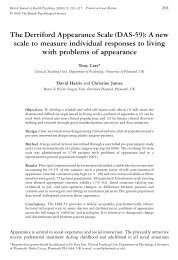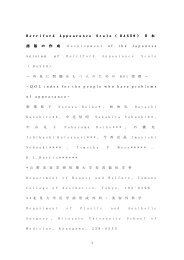DAS59 - Derriford Appearance Scales
DAS59 - Derriford Appearance Scales
DAS59 - Derriford Appearance Scales
You also want an ePaper? Increase the reach of your titles
YUMPU automatically turns print PDFs into web optimized ePapers that Google loves.
The <strong>Derriford</strong> <strong>Appearance</strong> Scale (<strong>DAS59</strong>) 219<br />
Table 2 Mean preoperative <strong>DAS59</strong> scores (full-scale and factorial sub-scales) of<br />
patients in a range of treatment-defined sub-groups of plastic surgery<br />
Operation n Full-scale GSC SSC NSC SBSC FSC<br />
abdominoplasty 123 124.2 48.2 28.5 14.9 27.3 1.8<br />
breast reduction 125 123.6 44.4 32.8 15.7 24.8 1.8<br />
breast augmentation 49 119.7 46.1 27.1 17.2 24.7 1.6<br />
otoplasty, men 31 113.8 42.3 29.5 16.6 13.6 6.3<br />
gynaecomastia 34 110.6 42.2 28.5 13.1 20.9 2.2<br />
mastopexy 20 107.4 38.4 23.6 16.3 22.1 2.7<br />
rhinoplasty, women 128 103.2 42.6 25.9 14.5 11.1 4.4<br />
breast asymmetry 13 102.5 34.1 26.7 15.1 21.2 2.5<br />
otoplasty, women 47 101.1 35.7 24.1 15.5 14.8 7.5<br />
breast reconstruction 11 95.1 32.7 21.3 15.8 21.6 1.2<br />
rhinoplasty, men 80 83.2 30.5 22.2 14.9 8.7 2.6<br />
facelift, women 32 77.6 32.2 16.7 13.8 8.7 2.4<br />
cosmetic, women 698 112.1 43.4 26.7 15.2 20.4 2.5<br />
cosmetic, men 116 89.4 32.9 23.7 14.4 11.6 2.5<br />
reconstructive, women 287 103.6 40.8 24.1 14.7 15.3 4.2<br />
reconstructive, men 147 96.8 37.1 24.4 15.4 10.9 3.7<br />
GSC: general self-consciousness of appearance; SSC: social self-consciousness of appearance;<br />
NSC: negative self-concept; SBSC: sexual and bodily self-consciousness of appearance; FSC:<br />
facial self-consciousness of appearance.<br />
Table 3 <strong>DAS59</strong> full-scale normative data for general and clinical populations by gender and by age bands (18–30 years, 31–60<br />
years and 61 years and over): minimum, maximum and quartile (Q1, Q2 and Q3) values, means and standard deviations<br />
General population: not concerned General population: concerned Clinical population<br />
Age (year) 18–30 31–60 61� 18–30 31–60 61� 18–30 31–60 61�<br />
Men<br />
minimum 8 8 8 30 8 9 26 10 10<br />
Q1 17 13 12 66 57 24 73 58 29<br />
Q2 28 21 19 83 77 35 93 85 64<br />
Q3 46 51 46 107 97 74 124 118 76<br />
maximum * 70 76 71 153 143 137 174 179 130<br />
mean 33.3 32.0 29.3 85.5 76.7 52.6 98.3 89.8 60.6<br />
(�s.d.) (18.5) (22.0) (20.7) (34.2) (33.3) (42.3) (38.1) (44.4) (34.8)<br />
n 50 156 80 60 80 16 146 121 27<br />
Women<br />
minimum 8 8 8 21 13 17 17 11 12<br />
Q1 15 12 12 63 55 44 88 71 53<br />
Q2 37 17 19 83 77 60 110 102 76<br />
Q3 59 23 28 102 104 80 144 131 109<br />
maximum * 92 56 57 160 161 114 172 191 155<br />
mean) 40.0 22.0 24.0 86.1 82.2 62.6 115.3 103.9 81.4<br />
(�s.d.) (26.2) (16.9) (16.3) (37.1) (39.2) (25.6) (38.4) (43.4) (36.8)<br />
n 57 123 61 102 188 27 400 637 67<br />
* Excludes outliers: value�mean�2 s.d.<br />
The general-population database was constructed from respondents<br />
to a postal study that involved 2700 residents of southwest<br />
Devon aged 18 years and over who were randomly selected<br />
from a total population of 583 000 with constraints for sex,<br />
socio-economic status, urban/rural residence and age. 25<br />
Table 3 lists the <strong>DAS59</strong> full-scale scores that subdivide these<br />
populations into quartiles (minimum–Q1, Q1–Q2, Q2–Q3 and<br />
Q3–maximum) together with the mean scores and standard<br />
deviations. As the <strong>DAS59</strong> discriminates significant differences<br />
in levels of distress and dysfunction between men and women and<br />
between different times of life, normative data for each sex are<br />
tabulated for early adulthood (age: 18–30 years), mid-adulthood<br />
(age: 31–60 years) and late adulthood (age: 61 years and over).<br />
For all age groups, all scores for the clinical population exceed<br />
the scores for the general population concerned about appearance,<br />
and both are substantially higher than the scores for the general<br />
population not concerned about appearance. In the general<br />
population concerned about appearance and in the clinical population,<br />
the mean scores for women are consistently higher than<br />
those for men and in the clinical population the difference is significant<br />
(P�0.0001). In both populations there is a serial reduction<br />
in the mean <strong>DAS59</strong> scores with increasing age. Among<br />
women in the clinical population, the reduction is significant<br />
from early to mid-adulthood (P�0.001) and from mid- to late<br />
adulthood (P�0.001). For men, the reduction is significant<br />
from mid- to late adulthood (P�0.01).<br />
Factorial sub-scales of the <strong>DAS59</strong><br />
Factor analysis groups together scale-items that score in similar<br />
ways. This helps in the selection of items during the refinement<br />
of a scale and contributes to an understanding of what a scale is<br />
measuring. Factor analysis (Principal components and Varimax





